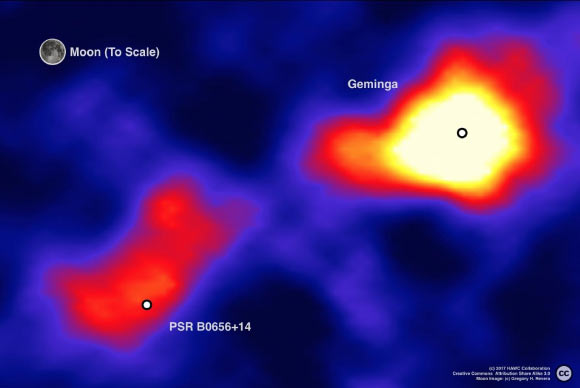Astrophysicists using the High-Altitude Water Cherenkov (HAWC) Gamma-Ray Observatory in Mexico have detected the extended emission of high-energy gamma rays around two nearby middle-aged pulsars, generated by high-energy electrons and their antimatter counterpart, the positrons. The properties of the detected emission cast serious doubt on one possible origin for a mysterious excess of positrons near Earth.

HAWC map for the region around Geminga (about 815 light-years away in the constellation Gemini) and PSR B0656+14 (about 940 light-years away). Image credit: John Pretz.
In 2008, astrophysicists observed an unexpectedly high number of positrons in orbit a few hundred miles above Earth’s atmosphere.
Ever since, they have debated the cause of the anomaly, split over two competing theories of its origin.
Some suggested a simple explanation — the extra particles might come from pulsars, which spin around several times a second and throw off electrons, positrons and other matter with violent force.
Others speculated that the extra positrons might come from processes involving dark matter — the invisible but pervasive substance seen so far only through its gravitational pull.
Using the HAWC data, University of Utah astrophysicist Anushka Udara Abeysekara and his colleagues made the first detailed measurements of two pulsars, called Geminga and PSR B0656+14, previously identified as possible sources of the positron excess.
Because the extended emission is generated by high-energy electrons and positrons, studying the properties of these emissions helped the team calculate how far positrons generated by the pulsars could diffuse through space.
“The HAWC Observatory sits at an elevation of 13,500 feet, flanking the Sierra Negra volcano inside Pico de Orizaba National Park in the Mexican state of Puebla,” the scientists said.
“It consists of more than 300 massive water tanks that sit waiting for cascades of particles initiated by gamma rays — many of which have more than 10 million times the energy of a dental X-ray.”
“When these gamma rays smash into the upper atmosphere, they blast apart atoms in the air, producing a shower of particles that moves at nearly the speed of light toward the ground. When this shower reaches HAWC’s tanks, it produces coordinated flashes of blue light in the water, allowing us to reconstruct the energy and cosmic origin of the gamma ray that kicked off the cascade.”
The team’s results demonstrate that positrons generated by Geminga and PSR B0656+14 pulsars are not able to reach all the way to Earth.
“We determined that nearby pulsars Geminga and PSR B0656+14 are not sources of the positron excess. Even though the two pulsars are old enough and close enough to account for the excess, matter isn’t drifting away from the pulsars fast enough to have reached the Earth,” the researchers said.
“Our analysis does not support previous claims that the two nearby pulsars are responsible for the excess of positrons detected by two space-born telescopes, the Italian-lead PAMELA project and the AMS-02 detector of NASA,” said Dr. Petra Huentemeyer, associate professor physics at Michigan Technological University and founding member of the HAWC Collaboration.
“The gamma rays HAWC measures demonstrate that there are high-energy positrons escaping from these sources. But according to our measurement, they could not be significantly contributing to the extra positrons seen at the Earth,” said Dr. Rubén López-Coto, a scientist at the Max Planck Institute for Nuclear Physics in Germany.
According to the team, the excess positrons arriving at our planet must have a more exotic origin, perhaps due to annihilation or decay of dark matter particles, among other possibilities.
Details of the research are published in the journal Science.
_____
A.U. Abeysekara et al. 2017. Extended gamma-ray sources around pulsars constrain the origin of the positron flux at Earth. Science 358 (6365): 911-914; doi: 10.1126/science.aan4880







